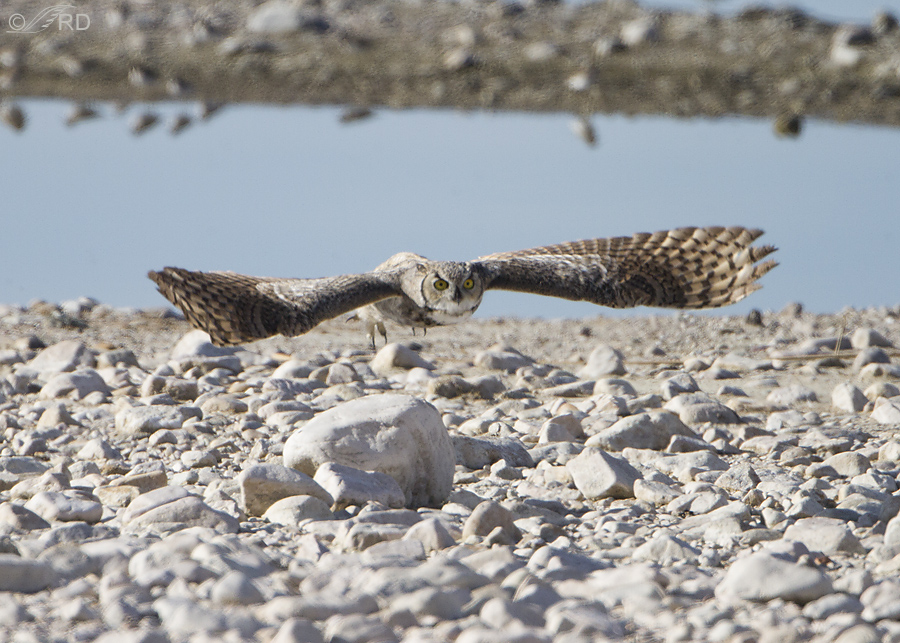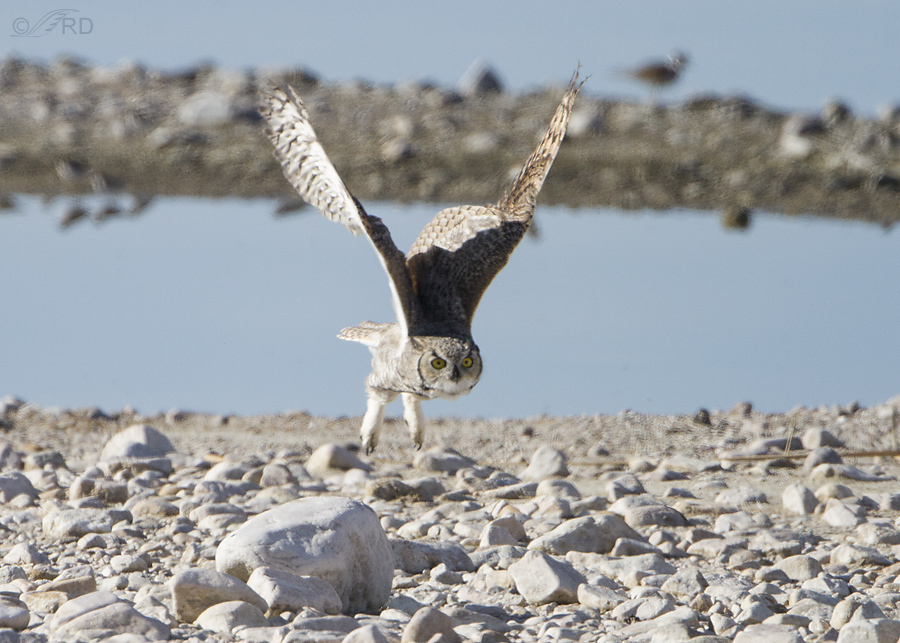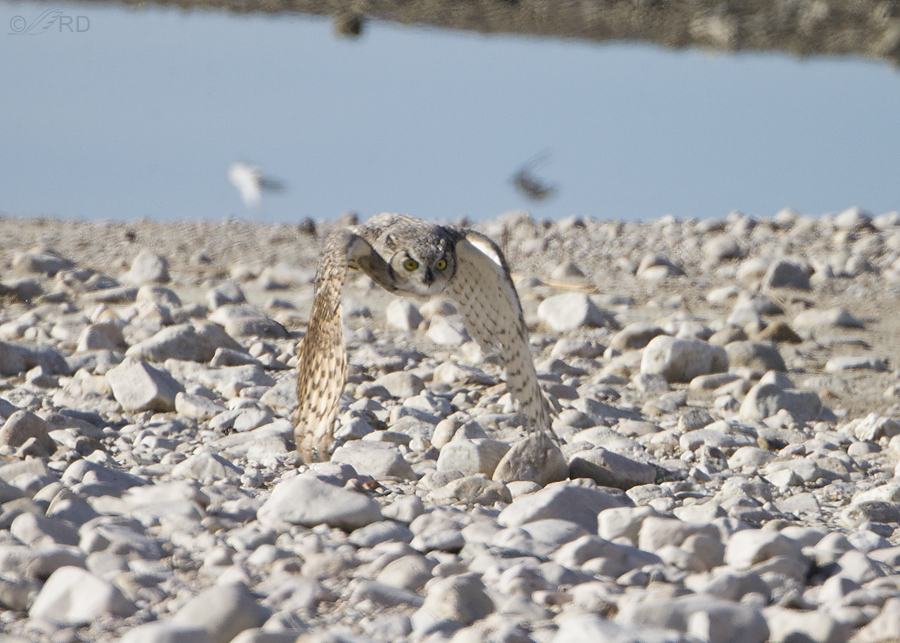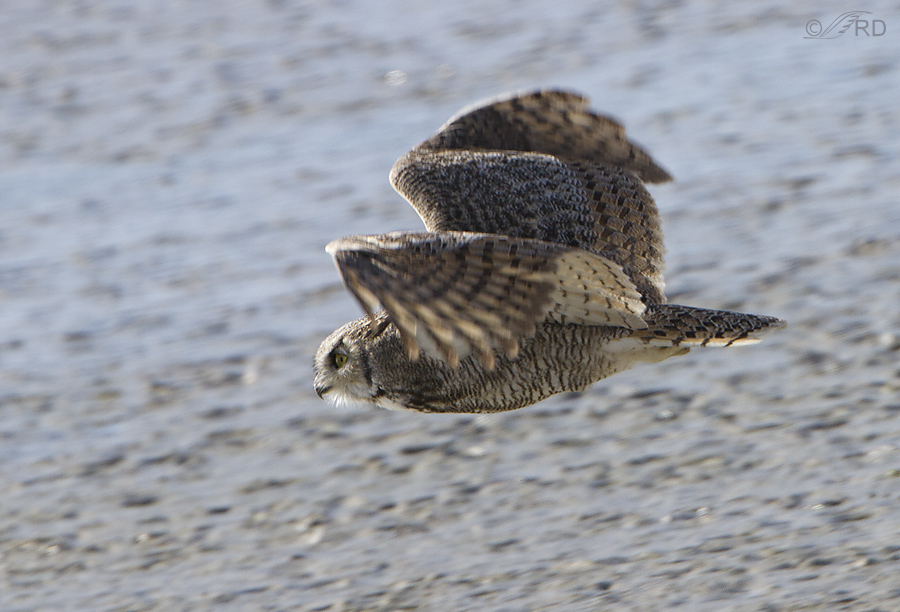Just a quick post to report what was an unusual event this morning, at least for me. This is simply a documentary post, as the photos are of mediocre quality.
In the hundreds of mornings I’ve spent on the island, I’ve never seen a Great Horned Owl along the causeway. This one was perched on some rocks on the south side of the first bridge.
But it flew a quarter-mile west before I got any shots off so I followed it and just as I was about to click the shutter it took off again and headed back to the same area by the first bridge…

where it perched on another rock.

After a few minutes…

it took off once again…

and headed almost straight for me. This is the last shot I got before it disappeared below the rabbitbrush along the side of the bridge.
Many thanks to the generous couple who approached my vehicle as I was photographing a coyote on the other side of the bridge (where the light was at a much better angle) and told us about this owl. Without their kind notification we’d have never even known the bird was there.
I’ve seen and photographed GHO’s multiple times on the island, in a variety of settings, but had never before seen one on the causeway. And it was even relatively late in the morning (10:30 AM) which surprised me further, since it was so much out in the open.
Ron



Beautiful shots of a magnificent bird!
Just wonderful!
Funny how awesome bird photographers often refer to certain shots as “mediocre” or “barely share-worthy”, when they are far superior to my own photography. It kinda hurts my feelings when I see people like you say that. 😉
When you’re great at something, just be okay with admitting it!
Thanks very much, Robert. But it really wasn’t false modesty when I called these photos “mediocre” in quality. They’re not all that sharp and the light angle was poor. I think their greatest quality is simply documenting a GHO on the causeway, but the biologist in me certainly doesn’t have anything against documentary shots – in fact, I’m very happy to have these images.
But your comment made me smile. Thank you.
Stunning!!
I adore these creatures — their wingspans are just phenomenal. We see them swoop on our hikes from one section of swamp to another — quite often in the day, as it’s dark in the swamp — but too quick for me to get a shot in. But the sound of their wings, and their sheer size of their wingspan… wow. Forever embedded in the memory!
I agree Christina – that wingspan sure gets your attention when you’re close to the owl.
Joy and bliss. Thank you.
And thank you, Elephant’s Child.
This is a beautiful owl. What a great adventure you have each day!
Thanks, Teri. “Adventure” is right – I just never know what I’m going to see out there. Or anywhere I go for birds. Such fun…
Beautiful! and perfect for Halloween!
You’re right, Tana. I didn’t even think of the Halloween connection…
Yes, I am jealous of you in that respect. I have to hunt for my birds in the trees, shrubs, etc. I wish all of mine would be out in the open. LOL!
I think it’s a tradeoff Bob. When we find birds they’re often out in the open (next trick is to try to get close), but because you have so much vegetation (cover for birds) you often have more birds and can get closer. At least that’s my impression – I’ve never been to Texas.
Wow that is odd, I think you got lucky There.
Thanks for shareing the great Pictures. No pun intended.
Earl, Yes I got lucky, thanks to that nice couple. Sure never expected to see one out there, especially during the day.
You got some very satisfactory shots, I think. All of the shots of GHOs that I have taken were in the day-light. So I can attest that it is possible to see them in daylight, despite some friends of mine that say that you must hunt them at night to get a chance to view them. It is such a surprise to come up on one, though.
Thanks Bob. All of mine of this species were taken in daylight too (guess that’s because photography requires light and I refuse to flash birds). What surprised me was to see this owl so much out in the open at that time of day. Nearly always when I see them during daytime, they’re hunkered down in a tree, building or some other cover. There are no trees or significant cover within several miles of where I found this bird.